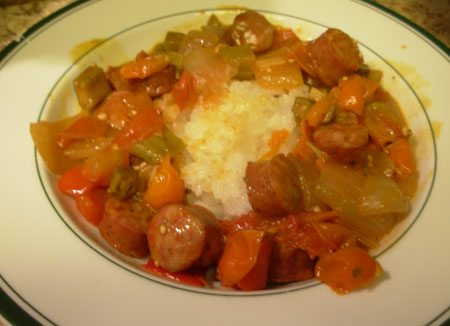Last week’s CSA brought a lot of peppers and okra. Thankfully, tomato season is over, and we’re moving towards the late-summer veggies I enjoy more, but peppers especially just seem to streeeeetch—you use two or three in a dish every day, and there are always two or three more at the bottom of the produce drawer.
I tweeted a request for peppers-and-okra recipes yesterday and got a great suggestion from Christy at Life of a Turnip: gumbo. I’m sure her recipe is great, but I just kinda winged it and came up with some very tasty gumbo. It’s another one of those recipes that can use pretty much anything you’ve got.
My version managed to be almost completely local, including the meat. I’m a proud Pollan-ite today! (Though I don’t really know of locally grown sources for rice and spices—any ideas?)
Now, there are three ways to thicken gumbo: a flour-and-fat roux, filé powder (ground sassafras leaves), and okra. Purists will tell you that none of these thickening agents should ever mix—you’ll find no okra in a real roux gumbo, and vice-versa. Since roux is a pain to make, filé is a pain to find, and my goal was to use up my okra, I made okra gumbo.
There are basically six ingredients to okra gumbo:
• Okra. You know that sticky goop that gets all over your knife and cutting board when you slice okra? That’s what thickens this gumbo. You cook it long enough that the slimy texture of the pods themselves turns into silky tenderness, but the seeds still pop in your mouth for some textural interest. Slice however much okra you want to use into 1/4- or 1/2-inch pieces.
• Veggies. Onion, bell pepper, and celery (AKA the Cajun Trinity) are traditional, but you can use anything you want. I used just onion and peppers—no celery in the fridge. Chop all your veggies into roughly equal pieces. You want about the same amount of total veggies as you have of okra. (Note: Tomatoes don’t count as veggies; see below.)
• Tomatoes. Tomatoes contain a lot of liquid, which will create the base of the gumbo (it’s a stew, after all). You can use canned or fresh; either way, chop the tomatoes into pieces similar in size to your veggies. You need about as much tomato as your okra and veggies put together—a bit less if you want a thicker gumbo.
• Meat. I’m hard-pressed to think of a meat that can’t go into gumbo. Bacon, sausage, chicken, pork, ham, shrimp, crab, crawfish, fish, alligator, frog’s legs—any, or any combination, will work. Figure two to four ounces total per serving. If you’re using bacon, crisp it in the pan first, then remove, cook the veggies in the fat, and throw it back in with the tomatoes. If using seafood, add just a few minutes before serving, just long enough to cook through. If using anything else, toss it in with the tomatoes. My local gumbo used Monroe Sausage, which is almost unfathomably delicious, made in Beatrice, Ala., and can be purchased at Pepper Place every Saturday.
• Seasonings. Some bay leaves, salt, pepper, and cayenne are necessary. Anything else is optional. If you use fresh herbs, add them right before serving.
• Rice. Gumbo is almost always served over rice. All you need to do is cook some rice. White, brown, long or short grain; doesn’t matter.
Here’s how to make it: Saute the okra and veggies (no tomatoes yet) in vegetable oil or bacon grease over medium-high heat until softened and starting to brown. Add the meat (unless you’re using seafood), tomatoes, and a few bay leaves, bring to a simmer, reduce heat to medium-low, and let cook for 30 minutes to an hour, stirring occasionally. The tomatoes will break down, creating a thick stew consistency. If the gumbo gets too thick, add a little chicken stock or water. If it’s too thin, let it cook a little longer and boil off more liquid. If using seafood, add it about 10 minutes before serving, just long enough to cook through. Season to taste with salt, pepper, cayenne, and any other desired herbs and spices. To serve, place scoops of rice in the center of shallow bowls and spoon gumbo around them.
